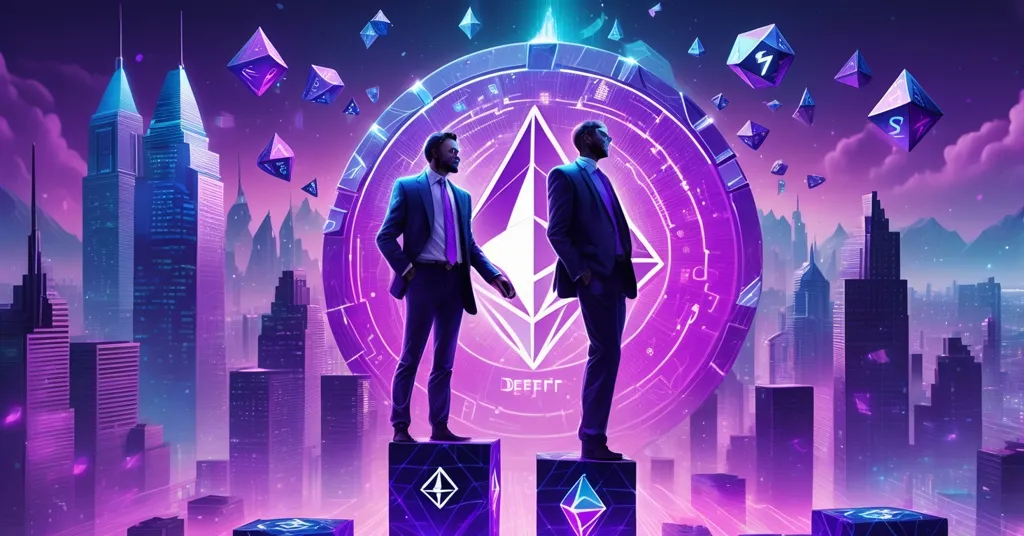Sharplink Gaming’s $400M Ethereum Bet: Bold Move or Risky Gamble in DeFi?

Sharplink Gaming’s $400 Million Ethereum Gamble: A Bold Bet on Decentralized Finance
Is Ethereum becoming the holy grail of corporate treasuries? Sharplink Gaming, a key player in online gaming marketing, is making a thunderous statement with a $400 million capital raise through a registered direct offering. Their goal? To catapult their Ethereum (ETH) holdings beyond $3 billion, positioning themselves at the forefront of a seismic shift toward cryptocurrency as a core financial asset in the age of decentralized finance (DeFi).
- Capital Raise: $400 million via share sales at $21.76 each to five global investors.
- ETH Target: Over $3 billion in ETH, roughly 1% of circulating supply.
- Current Holdings: 598,800 ETH, valued at over $2.5 billion as of August 10, 2025.
Sharplink Gaming’s Big Play: Diving Deep into Ethereum
Sharplink Gaming isn’t your typical crypto poster child. As an online gaming marketer, they’ve built a business bridging digital entertainment and advertising, raking in revenue by connecting brands with gamers. But their latest move is anything but traditional. Raising $400 million through share sales at $21.76 apiece to a handful of global investors, they’re hell-bent on amassing Ethereum reserves that could rival some of the biggest players in the space. Their stock reflected the market’s bipolar reaction—opening at $24, soaring to $28, then sliding to $22.34, a 6.63% intraday drop but still up a solid 17.55% over the week. Investors are clearly buzzing with excitement over this crypto pivot, yet wary of hitching their wagon to a notoriously volatile asset.
The deal, orchestrated with Alliance Global Partners (AGP) as the placement agent and Cantor as financial advisor, sticks to SEC guidelines under Form S-3ASR (effective since May 30, 2025) and is expected to wrap up on August 12, 2025. Sharplink’s fundraising muscle doesn’t stop there—they’ve pulled in nearly $900 million in the past week, with an extra $200 million from market program proceeds waiting to fuel more ETH accumulation. This isn’t a cautious toe-dip; it’s a full-on plunge into the deep end of blockchain-based finance, as detailed in their Ethereum holdings strategy.
Joseph Chalom, co-CEO of Sharplink, didn’t mince words on the momentum: “Raising nearly $900 million in capital over the past week underscores the market’s confidence in our ETH treasury strategy. This isn’t just faith in Sharplink—it’s a vote for Ethereum as a transformative force in global finance.”
Ethereum 101: Why It’s More Than Just Digital Cash
For anyone new to the crypto game, let’s break down why Ethereum is such a big deal. It’s the second-largest cryptocurrency by market cap, often hailed as the engine of decentralized finance, or DeFi. Unlike Bitcoin, which is mainly seen as “digital gold”—a way to store value against inflation—Ethereum’s blockchain is a programmable platform. Developers use it to build decentralized apps (dApps) and smart contracts, which are self-executing agreements coded to run without intermediaries. Think of smart contracts as vending machines for finance: insert the right inputs, and the deal happens automatically. For a deeper dive into its mechanics, check out this Ethereum overview.
Ethereum also lets users “stake” their ETH, locking it up to help secure the network while earning rewards, much like earning interest by renting out your crypto. This opens doors to active income in ways Bitcoin can’t match, powering everything from lending platforms to NFT markets. Sharplink’s fixation on ETH isn’t about hoarding a shiny coin; it’s a calculated bet on a future where financial systems run on code, not centralized banks or bureaucrats.
The Corporate ETH Gold Rush: Sharplink Joins the Fray
Sharplink isn’t forging this path alone. Public companies are stacking ETH like it’s the last resource on Earth. BitMine holds a staggering 1.2 million ETH, while EtherMachine and BitDigital sit on 345,362 and 120,306 ETH respectively. In a mere two months, corporate treasuries have snapped up 1% of ETH’s circulating supply—around $9 billion at current prices. For more on these trends, explore this analysis of corporate ETH holdings. Ethereum’s market performance only adds fuel to the fire, trading at $4,229 with a 9.5% weekly gain and a whopping 45.3% monthly surge, though it’s still 13% shy of its all-time high of $4,878. Standard Chartered’s Geoff Kendrick has thrown out a bold forecast, suggesting public ETH treasuries could eventually control 10% of the total supply. But let’s cut through the noise—price predictions are often just snake oil peddled by wannabe oracles. The real pull is Ethereum’s raw utility. Since June 2025, DeFi and staking adoption has outpaced Bitcoin treasury growth by double, making ETH an irresistible target for risk-hungry firms like Sharplink.
The Dark Side of ETH Treasuries: Risks That Can’t Be Ignored
Before we start painting Sharplink as the next financial visionary, let’s talk about the elephant in the room: the risks are as real as a heart attack. Bernstein analysts have been sounding the alarm on companies piling into ETH treasuries, and they’ve got a point. Liquidity is a massive hurdle—staked ETH often comes with strings attached, including “unstaking queues” that can delay withdrawals for weeks or even months. Imagine needing quick cash during a market crash, only to find your billions locked up tighter than Fort Knox. That’s a recipe for disaster, as highlighted in this report on DeFi liquidity risks.
Then there’s the minefield of DeFi itself. Smart contracts, while brilliant, are magnets for hackers. Take the 2022 Ronin Bridge hack—over $600 million vanished into thin air due to a coding flaw. Poof. Just like that. Regulatory uncertainty adds another layer of pain. Decentralized autonomous organizations (DAOs) and DeFi protocols often operate in a legal no-man’s-land. If the SEC brands staked ETH as a security, or if global frameworks like the EU’s MiCA clash with U.S. indecision, Sharplink could face a compliance nightmare. Aiming for 1% of ETH’s supply sounds epic—until it turns into a balance-sheet implosion, a concern echoed in discussions on Ethereum treasury risks. We’re not here to sugarcoat it; this is high-stakes poker, and not everyone leaves the table a winner.
The Sweet Spot: Ethereum’s Yield Potential Trumps Bitcoin
Now, let’s flip to the upside, because it’s damn tempting. Bernstein estimates that a $1 billion ETH treasury could pull in $30-50 million annually through staking and DeFi protocols, provided legal and governance kinks get ironed out. How does this work? Staking alone offers 3-5% returns just for helping secure the network, while lending ETH on platforms like Aave or providing liquidity on Curve can push yields even higher. Compare that to U.S. Treasury bonds crawling at 2-3%—this isn’t just a store of value; it’s a money-making machine. Bitcoin’s “buy and hold” mantra looks downright boring next to ETH’s active income streams, and that’s likely why Sharplink chose this route, a sentiment shared in conversations on why companies pick Ethereum. Picture a corporate treasury not just sitting idle, but lending and earning in real-time on a decentralized network. That’s not just disruptive—it’s a middle finger to traditional finance.
Ethereum vs. Bitcoin: A Treasury Tug-of-War
Stacking Sharplink’s strategy against Bitcoin treasury titans like MicroStrategy reveals a stark divide in crypto thinking. MicroStrategy, led by Bitcoin evangelist Michael Saylor, has hoarded over 200,000 BTC worth billions since 2020, pitching it as a shield against fiat collapse. Their playbook is straightforward: buy, hold, and ride out the volatility. Ethereum’s story is messier but packed with potential, tied to programmable finance, staking, and DeFi yields. Bitcoin maximalists—and I’ll admit, we lean that way—might scoff at ETH’s added complexity, arguing it’s a reckless gamble when BTC’s simplicity as digital gold reigns supreme. They’ve got a point; Bitcoin’s narrative is cleaner, less prone to the tech hiccups that plague DeFi. But you can’t deny ETH fills a gap Bitcoin doesn’t touch. For firms like Sharplink willing to stomach the risk, ETH offers a dynamic edge—a chance to actively grow wealth, not just preserve it. This diversity of purpose is what makes the blockchain space so damn exciting, as discussed in online forums like Reddit threads on Sharplink’s ETH strategy.
Decentralization on the Line: The Corporate ETH Arms Race
Here’s where things get thorny. With BitMine reportedly targeting 5% of ETH’s supply and Sharplink gunning for 1%, we’re witnessing a corporate scramble that could have unintended consequences. What does this mean for Ethereum’s decentralization—a principle we hold sacred? If a few big players control massive chunks of ETH, they could wield outsized influence over governance in DAOs or sway network upgrades, undermining the community-driven ethos at the heart of blockchain. We’re not crying wolf here; it’s a legitimate concern. Imagine a future where corporate whales call the shots, turning a decentralized utopia into just another power grab, a topic explored in this piece on corporate ETH impact. As much as we root for crypto’s mainstream rise, this concentration of control deserves a hard look. Freedom isn’t just about breaking free from banks—it’s about ensuring no new overlords take their place.
Key Takeaways and Critical Questions
- Why is Sharplink Gaming pouring $400 million into Ethereum?
They view ETH as a foundational treasury asset, banking on DeFi’s explosive rise and Ethereum’s enduring value, fueled by nearly $900 million in recent investor backing. - How common is corporate Ethereum accumulation?
It’s a striking trend—public treasuries have seized 1% of ETH supply ($9 billion) in two months, with projections hinting at 10%, marking a profound shift in institutional confidence. - What perils await Sharplink with such heavy ETH exposure?
They face daunting challenges like liquidity snarls from staking, smart contract exploits in DeFi, and regulatory minefields that could destabilize their treasury. - Why opt for Ethereum over Bitcoin in a corporate treasury?
ETH brings active yields through staking and DeFi—potentially 3-5% or more yearly—versus Bitcoin’s passive “digital gold” approach, though it carries sharper risks. - Does corporate ETH hoarding threaten decentralization?
Quite possibly—huge reserves held by firms like BitMine and Sharplink risk centralizing control, clashing with Ethereum’s vision of a community-led network.
Sharplink Gaming’s $400 million raise isn’t just another financial headline—it’s a raw look at the collision between traditional corporate strategy and blockchain’s untamed potential. The promise of groundbreaking profits and disruption is sky-high, but the pitfalls are just as steep: liquidity traps, DeFi meltdowns, and the looming shadow of centralized power in a decentralized world. As fierce advocates for freedom, privacy, and tearing down the status quo, we cheer the audacity but demand vigilance. This isn’t a playground for the timid, and Sharplink’s wager could either redefine how companies wield wealth or become a brutal cautionary tale in crypto’s wild frontier. Are we witnessing the dawn of mainstream blockchain adoption, or just trading one set of chains for another? The answer will shape the future of finance.



